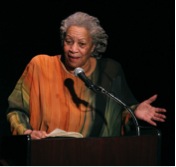Solomon done fly, Solomon done gone
Solomon cut across the sky, Solomon gone home.
So goes the song Milkman Dead discovers in his quest to learn the story of his father’s family.
Solomon, the flying African, is at the center of Toni Morrison’s 1977 novel, Song of Solomon – hands down my favorite novel of all time. (And it’s President Obama’s favorite book, too!)
It’s a mythic quest (think Joseph Campbell’s hero’s journey). It’s a detective novel. It’s an African American folktale. It’s a fairy tale. It’s a magical realist novel. It’s a genealogical expedition. It’s an epic story of a people. It’s a family saga. It’s a coming-of-age tale. It’s all that – and more.
This is a book you can’t put down – a page-turner that will keep you up till all hours – and it’s a book that will teach you so much about African American history, traditions, and folk culture.
Born in 1931, Toni Morrison is the only African American to have been awarded the Nobel Prize in Literature. To my mind, she is our greatest living American writer – a true treasure. She’s written ten novels, and Song of Solomon is a fantastic starting point for getting to know her work.
At the heart of the novel is the African American legend of the flying Africans. The New Georgia Encyclopedia explains the tale this way:
The historical roots of the flying Africans legend can be traced back to the spring of 1803, when a group of Igbo slaves arrived in Savannah after enduring the nightmare of the Middle Passage. The Igbo (from what is now the nation of Nigeria, in central West Africa) were renowned throughout the American South for being fiercely independent and unwilling to tolerate the humiliations of chattel slavery. The Igbo who became known as the flying Africans were purchased at the slave market in Savannah.
When they landed at St. Simons, Georgia, the Igbo slaves rose up and escaped. Some accounts say they walked on water back to Africa. Some say they turned into the water and drowned. Some, like this former slave, say they flew as a group back to their homeland:
At that time Mr. Blue he was the overseer and . . . Mr. Blue he go down one morning with a long whip for to whip them good. . . . Anyway, he whipped them good and they got together and stuck that hoe in the field and then . . . rose up in the sky and turned themselves into buzzards and flew right back to Africa. . . . Everybody knows about them.
This story – told over and over again in African American communities throughout the New World – forms the backbone of Morrison’s novel. It’s also at the heart of Virginia Hamilton’s award-winning children’s book, The People Could Fly, and Julie Dash’s one-of-a-kind film, Daughters of the Dust. I’ll tell you about The People Could Fly next week and introduce you to Daughters of the Dust the week after that. Stay tuned!
Join me this week on Pinterest as I pin images and resources related to Toni Morrison. Take a look around at all my boards – or go straight to “My Favorite Books” board for Toni Morrison treats.
And don’t forget to leave a comment on this post! If you subscribe to the weekly StoryWeb email and leave a comment here, you’ll be entered into a monthly drawing to win a StoryWeb T-shirt.
Podcast: Play in new window | Download
Subscribe to StoryWeb in iTunes.Subscribe to StoryWeb in Stitcher.
Image credit: See https://en.wikipedia.org/wiki/File:Toni_Morrison_2008-2.jpg.
